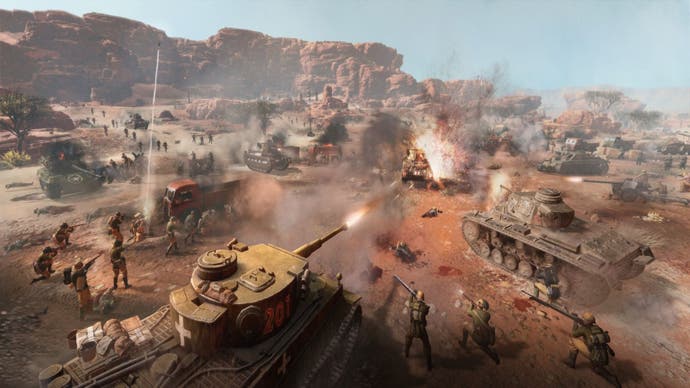Company of Heroes 3 review - supreme competency without a big innovation
Wartime Relic.
Let's get this one out of the way early: there's a certain strangeness - or worse - to talking about how good the bits where you get to play as Erwin Rommel are in a video game. This is the odd situation that Company of Heroes 3 puts you in, however. A game that simulates war for fun, which releases, somewhat unbelievably, a day before the anniversary of the war in Ukraine, and is - despite the questionable nature of putting you in a Wehrmacht commander's shoes, and astonishingly poor decision-making behind its release date - somehow, a success. Company of Heroes 3 is very, very good, in part because great care has been taken with those gambles on its setting and tone.
That's not to say this is much of a surprise. Relic has been at the pinnacle of the RTS (real-time strategy) scene for some time now. There were some who might have worried after the mixed-at-best reactions to Dawn of War 3, which gambled much more aggressively on giving units active abilities and its multiplayer maps more defined 'lanes', but they shouldn't. Company of Heroes 3 is a conservative's dream, the ultimate safe bet of a sequel and a clear reaction to the studio getting its hands singed by DoW 3's creative chances. Here's everything you liked about Company of Heroes before now, plus more of it, plus everything's just that little bit better. There are few if any major innovations, just iteration, tuning, fiddling with dials.
But they're almost unanimously successful, those dials turned to just the places you'd want them to be - namely the ones for big explosions, tactical demands and gloriously recreated sounds, turned right up to the line before the last notch on the Realism Scale where you hit the range called Excess - and so in place of real novelty or proper creativity comes a supreme kind of competency. Mostly.
I've one hangup with CoH 3, which is its Italian Campaign. There are two single-player components with CoH 3, which is more than ever - a running theme - and arguably more than you'd ever really need. The Italian one is vast, by series standards, a sweeping spectacle that mixes the delightfully bureaucratic elements of the sandbox overworlds you'd find in the Total War games, with the more simplified, arcady joys of old Relic joints, like the planetary conquest of Dawn of War: Dark Crusade.
On paper much of it is great. You land at the tip of Italy's boot and work your way upwards, conquering settlements of varying sizes, sieging cities for multiple turns, risking ambush on faster roads or taking slower routes through the sun-dried Mediterranean hills. There are resources to manage - meta versions of the manpower, munitions and fuel of CoH's actual battles - and a variety of strategies to employ, from naval bombardment to artillery to paratroopers. You can see the shared talent from Creative Assembly at work - you'd imagine there's some serious cross-hiring between the two Sega-published strategy masters - and as someone who's longed for the return of stomping across maps and painting them all in your colours like we did in those Dawn of War days, I was desperately keen for this to work.
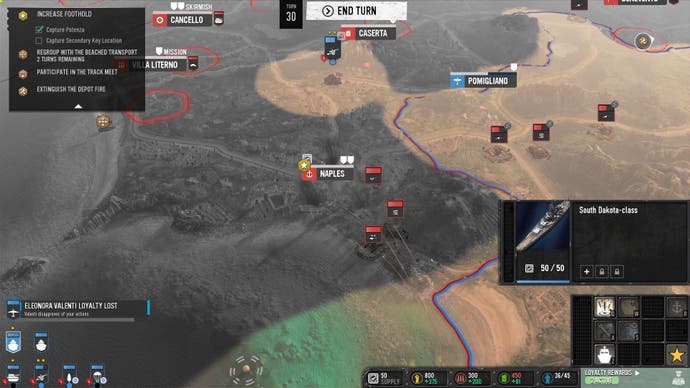
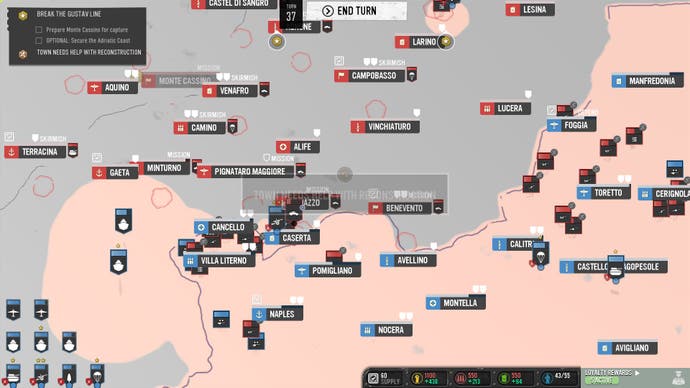
The problems arise from it being a mix of the two - hardcore strategy and pulpy fun - and ending in a kind of no man's land between them. Many elements feel too simple: auto-resolve is only half implemented, on certain battles, which leads to lots of manual fighting of short, repetitive skirmishes on the same maps (remixed objectives help to mix it up, but not enough) which exist in a kind of abstracted place. It makes sense that they're re-used: Company of Heroes maps are by necessity highly detailed, with specifically placed structures and cover systems, compared to the more generic bits of land you might find in Total War. But in this scenario they get old fast. Similarly, there are plenty of systems here but for much of the campaign - certainly the first third of it or so - there's really no need to engage with them at all. You can simply push your little men gradually up the country's spine, healing themselves for almost-nothing each turn (companies' overworld health also didn't seem to impact their actual strength in battle, as far as I could tell) until they hit enough of a choke point that you might want to bosh a few artillery strikes on it from your battleships, and continue on.
The desire, and perhaps necessity again, to tell a specific story of the US and British forces' liberation of Italy and its resistance fighters also limits the 'sandbox' nature of things. As far as sandboxes go it's a long, narrow one, where you have to start at one end and finish at the other, and always start on (variations of) the same team. Whichever you choose you'll be peppered with sub-objectives from three factions of allies - a pair of bickering British and US generals and an Italian resistance leader - which do add variety and a sense of dynamism to your advance. You're forced to adapt to their demands and try to keep all three happy - often their are fairly blunt tradeoffs between annoying one and pleasing another, tied to a loyalty system which progresses you through a tree of bonuses depending on how happy or huffy they are with your decisions - but when you're trying to, you know, win a war, at times this can devolve into a kind of relentless nagging. Go to a track meet! Save the historic church! Literally put out a fire! Advance now! Leave me alone!
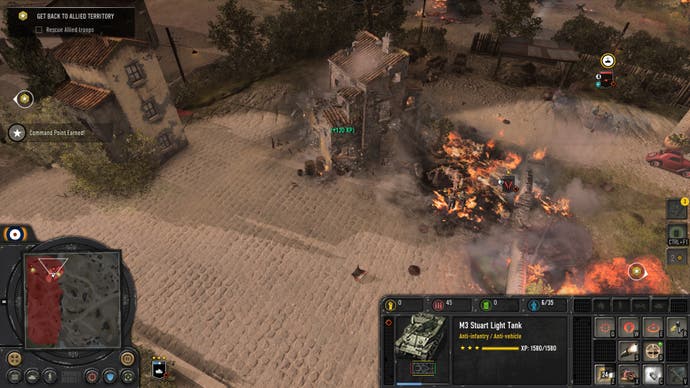
All of that said, this is still a new addition to Company of Heroes. It's still deeply rewarding, between the nuisances, to take part in multi-stage, objective-filled missions based on real battles. The Italian landscapes might seem like a "where's left in WW2?" option but they are gorgeously realised and a pleasant change from typical scenery. And fundamentally, shuffling little men around a big map remains an indisputable joy. You will have fun here, especially after the simpler open hours end and the variety and intensity of opposition ramps up. Just don't expect the vast replayability or more characterful schlock of other games that made conquest-style campaigns their sole attraction.
And again, this is just one part of Company of Heroes 3. The other half of single-player is its North African Operation, an eight-mission linear story that very closely mirrors what you'll have played in the single-player sections of Company of Heroes games before. This is the one which puts you in the shoes of Rommel, the 'Desert Fox' of the Second World War with something of a reputation. In the year since the Second World War Rommel has been romanticised and mythologised, proposed as a kind of "gentleman general" detached from all that horrible Nazi stuff. The reality of course is that a "gentlemanly" Nazi is still a Nazi - even one who, in Rommel's case, eventually died as a result of a plot to oust Adolf Hitler - and role-playing as a man who was known to support, or in some historians' words "worship" Hitler for much of the war, even in the context of detached, ironic moustache-twizzling and the undeniable fact that humans find a weird kind of fun in playing the virtual villain, remains deeply strange at very best.

Relic has, at least, been smart with an almost impossible task here - even if the team set that task for themselves. Between missions, the story of this part of the war is told from the perspective of local civilians, documenting the destruction and death amongst their homes, countering the sense that the North African conflict took place in some kind of well-mannered vacuum away from the unpleasantries of the war. As you advance, you'll hear as many cries from the British troops as you do your own. On loading screens you're read letters home from a local man they've recruited. There's no romanticising of Rommel or his DAK (Deutsches Afrika Korps), but nor is there an excessive over-correction or sanitisation. It's simply presented as-is - or rather as it was - and as all history should be: in the totality of its context.


You can't help but suspect the worst corners of military history gaming will still ignore that context when gleefully climbing into their Panzers, mind. Relic has at least attempted to reduce their excuse for doing so. But there is a lingering sense that no matter how many compassionately painted cutscenes you add around the edges, a series of missions from a given character's perspective will always default to a kind of sympathy without extra care. Normally, I'd say it's perfectly possible to bring your own criticism as an audience member, but this is the strange, foggy area where actively playing games departs from the hands-off experience of other media.
The missions themselves are exemplary: varied, challenging, often multi-staged and dynamic. You'll move from guiding a small group of tanks, to recovering and repurposing destroyed vehicles, to surviving assaults, planning pincer movements and landing counter-blows. The only possible criticism is that, without wider context beyond the choreographed missions, those incisive counters and intellectual out-flankings don't have much punch - you simply follow the objectives as commanded. You're left almost wanting a mix of the two campaigns, where you're guided through an overworld map and able to visualise and immerse yourself in the manoeuvres before actually executing them. But it's a small complaint really; the missions themselves are a blast.
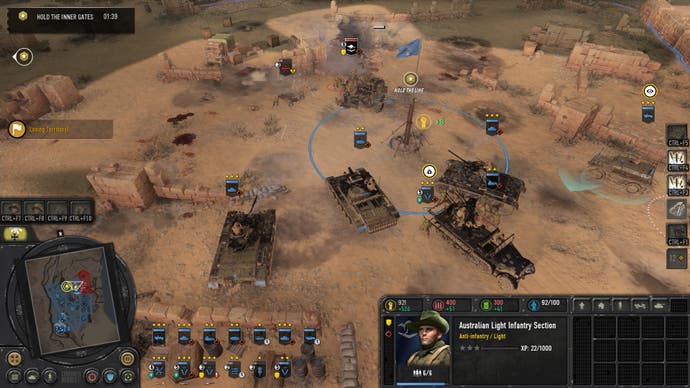
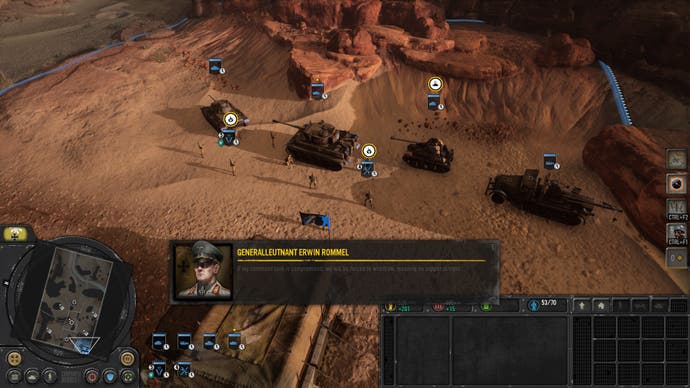
Speaking of, Company of Heroes 3 has added a wonderful sense of spectacle, and it compliments its little tweaks beautifully. The height of your troops now directly impacts sightlines, sight ranges, and cover, and so maps have considerably more 'verticality' - that lovely developer-favourite word - in the form of sand dunes, desert ruins, bell towers and occupied castles. Everything can be blown to bits, which dovetails rather nicely with a campaign about shooting things with tanks, and the series' famously on-point sound is a delight once more, realistic (I assume) but bombastic, the old cliché of Hollywood-meets-history ringing true, and quite loudly in your ears.
It's those things which made Company of Heroes the venerable great that it is which really elevate CoH 3, in fact. Relic's long-standing mastery of battlefield context is better than ever: units path intuitively, aside from the odd rogue tank, with squads naturally hopping low walls or lining up outside buildings to flush out an enemy squad (breaching is a new mechanic but honestly, close to a gimmick, being not hugely different to just lobbing a grenade into a building like you did before). It's more tactically complex than most RTS games but also more intuitive, because its tactics make sense: hit tanks from the rear or the side, don't run units across open roads or, now, up blind hills. Each new layer of complexity - more scouting units, more light and heavy tanks, more unit upgrades, structures, tools for setting and countering traps - comes with a kind of ready-made sense to it.

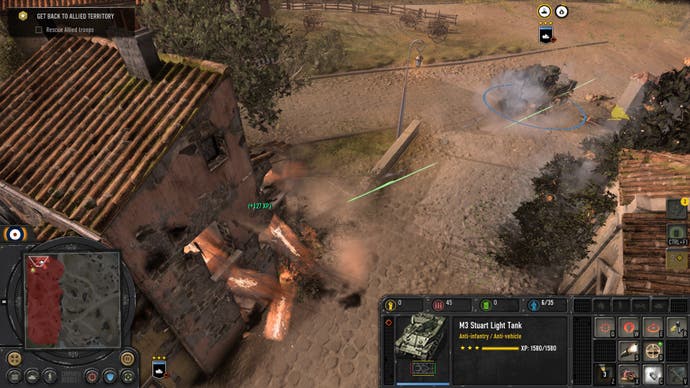
That being said, prepare for a challenge, as always, in multiplayer, where CoH 3's low barrier to entry but very, very high skill ceiling is as apparent as ever - at least in my brief and calamity-filled attempts at taking the fight to other humans online. The upside is, again, more variety than ever - 14 maps, four factions with three sub-faction 'battlegroups' within them, the most of each in the series at launch - with skirmishes, co-op, and even modability ready to go from the off. There's a fair bit of tonal similarity, but wonderful historic texture - I adore the implementation of special forces from wider parts of the world, the Gurkhas and Australians and Canadians, or even just varying British accents from cor-blimey-guv to the still effing-and-jeffing Welsh, all acting as reminder of the global scale of the Second World War, the human impact of it and the personal moments between the action.
The result, again, is a game that's far safer than it is inventive, one that trades on its pre-existing strengths - human touches, bombast, an unparalleled mix of tactical nuance and contextual immersion - more than it really adds anything new. Company of Heroes 3 is simply Company of Heroes, but more of it and better. In this case, that's more than enough.
